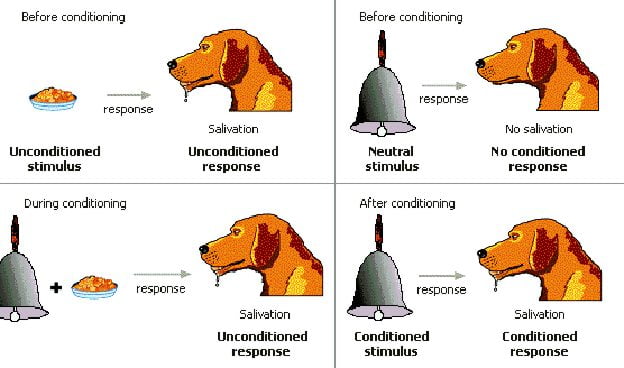Behaviourism or the Behavioural Learning Theory is a popular concept that focuses on how students learn. Behaviourism focuses on the idea that all behaviours are learned through interaction with the environment. This learning theory states that behaviours are learned from the environment, and says that innate or inherited factors have very little influence on behaviour.
Behaviourism started as a reaction against introspective psychology in the 19th century, which relied heavily on first-person accounts. Behavioural Psychology for language learning was developed starting with the Behavioural School of John B Watson and developing through Ivan Pavlov, Edward Lee Thorndike and B F Skinner. Pavlov and Thorndike conducted several experiments and Watson perfected their theories and Skinner applied them to language acquisition.
Watson and Skinner rejected introspective methods as being subjective and unquantifiable. They wanted to focus on observable, quantifiable events and behaviours. They said that science should take into account only observable indicators. They helped bring psychology into higher relevance by showing that it could be accurately measured and understood, and it wasn’t just based on opinions. Watson and Skinner believed that if they were given a group of infants, the way they were raised and the environment they put them in would be the ultimate determining factor for how they acted, not their parents or their genetics.
Pavlov’s Dogs is a popular behaviourism experiment. Pavlov was researching the digestion of dogs when he noticed that the dogs’ physical reactions to food subtly changed over time. At first, the dogs would only salivate when the food was placed in front of them. However, later they salivated slightly before their food arrived. Pavlov realized that they were salivating at the noises that were consistently present before the food arrived; for example, the sound of a food cart approaching. To test his theory, Pavlov set up an experiment in which he rang a bell shortly before presenting food to the dogs. At first, the dogs elicited no response to the bells. Eventually, the dogs began to salivate at the sound of the bell alone. This is exactly what behaviourism argues -that the things we experience and our environment are the drivers of how we act.

The stimulus-response sequence is a key element of understanding Behaviourism. A stimulus is given, for example, a bell rings, and the response is what happens next, a dog salivates or a pellet of food is given. Behavioural Learning Theory argues that even complex actions can be broken down into stimulus-response.
In the classroom, the Behavioural Learning Theory is key to understanding how to motivate and help students. Information is transferred from teachers to learners from a response to the right stimulus. Students are passive participants in Behavioural Learning—teachers are giving them the information as an element of stimulus-response. Teachers use Behaviourism to show students how they should react and respond to certain stimuli. This needs to be done repetitively, to regularly remind students what behaviour a teacher is looking for.
Positive reinforcement is key in the Behavioural Learning Theory. Without positive reinforcement, students will quickly abandon their responses because they don’t appear to be working. Repetition and positive reinforcement go hand-in-hand with the Behavioural Learning Theory. Teachers often work to strike the right balance between repeating the situation and having positive reinforcement come to show students why they should continue that behaviour. For example, if students are supposed to get a sticker every time they get an A on a test, and then teachers stop giving that positive reinforcement, fewer students may get A’s on their tests, because the behaviour isn’t connected to a reward for them.
Motivation plays an important role in Behavioural Learning. Positive and negative reinforcement can be motivators for students. For example, a student may receive praise for getting a good grade on a test, this is positive reinforcement. Negative reinforcement is still motivation to get the student to act in a desired way but removes an element to get the student to do something. For example, a student may not have to do homework if they score well on a test. Both of these motivators are valuable for improved behaviour inside the classroom.
The Behavioural Learning Theory and the Social Learning Theory stem from similar ideas. The Social Learning Theory agrees with the Behavioural Learning Theory about outside influences on behaviour. However, the Social Learning Theory goes a step further and suggests that internal psychological processes are also an influence on behaviour. Students or individuals may see things being done, but the Social Learning Theory says that internal thoughts impact what behaviour response comes out.
Teachers can implement behavioural learning strategy techniques in their classroom in many ways, including:
Drills: Teachers may practice skills using drill patterns to help students see the repetition and reinforcement that behavioural learning theory uses.
Question and answer: Teachers can use a question as a stimulus and an answer as a response, gradually getting harder with questions to help students.
Guided practice: Teachers can be directly involved in helping students go through problems to give them the reinforcement and behaviour demonstration you want them to follow.
Regular review: Reviews are important to behavioural learning theory. Going back over the material and giving positive reinforcement will help students retain information much better.
Positive reinforcement: Behaviourist classrooms utilize positive reinforcement regularly. This can be in the form of verbal reinforcement and praise, reward systems, added privileges, and more.
Criticism on Behaviourism
- Ethical and practical Issues of animal experiments. Skinner’s rats were exposed to stressful and aversive conditions. May have affected reactions.
- Mechanistic views of behaviour. Animals and humans are seen as passive and machine-like in their environment. Little or no conscious insight into behaviour.
- The Learning Theory may apply less to humans and more to animal behaviour.
- Environmental determinism. Determines behaviour is caused by experiences that have been conditioned. Doesn’t allow free will to play any part.
Chomsky criticizes Behaviourism because:
- it robs man of his essential quality.
- it is concerned only with the surface aspects leaving the core problem untouched.
- it fails to account for the complexity and creativity of language.





























